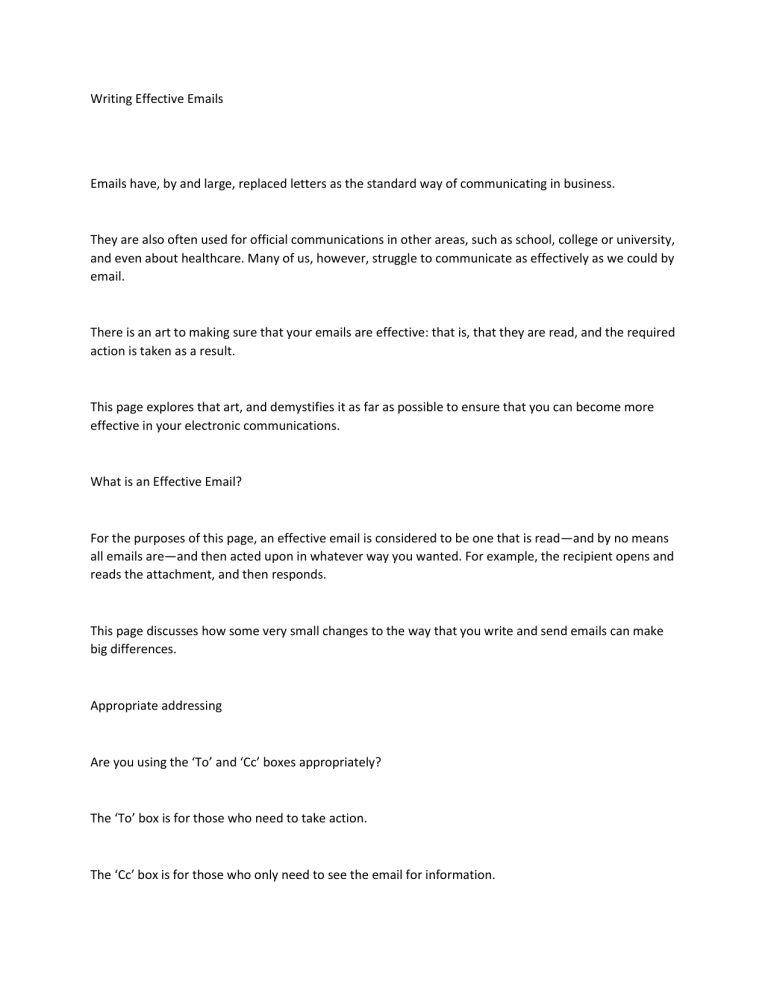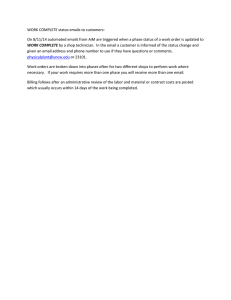Writing Effective Emails: A Guide to Clear Communication
advertisement

Writing Effective Emails Emails have, by and large, replaced letters as the standard way of communicating in business. They are also often used for official communications in other areas, such as school, college or university, and even about healthcare. Many of us, however, struggle to communicate as effectively as we could by email. There is an art to making sure that your emails are effective: that is, that they are read, and the required action is taken as a result. This page explores that art, and demystifies it as far as possible to ensure that you can become more effective in your electronic communications. What is an Effective Email? For the purposes of this page, an effective email is considered to be one that is read—and by no means all emails are—and then acted upon in whatever way you wanted. For example, the recipient opens and reads the attachment, and then responds. This page discusses how some very small changes to the way that you write and send emails can make big differences. Appropriate addressing Are you using the ‘To’ and ‘Cc’ boxes appropriately? The ‘To’ box is for those who need to take action. The ‘Cc’ box is for those who only need to see the email for information. Exception: Bcc Use ‘Bcc’ even if you need the recipients to take action where you need to protect the recipients’ email addresses, and not disclose them to others. For example, clubs or societies should use bcc in all mailings to club members, whether as a whole, or as specific sub-groups. If you wish to emphasise or explain why you have cc’d someone, add a sentence at the end of your email. The Subject The subject is a way to tell people what your email is about, and make it more likely to be opened. It is also a way to show quickly whether someone needs to read your email now or later. DO NOT use generic subjects like ‘Your last email’, or ‘Health’. Instead, make the subject as clear and explicit as possible, and also say what the recipient needs to do, for example: Subject: URGENT! READ NOW AND RESPOND: Consent needed for school trip Subject: FOR INFORMATION: Term dates for next year This will allow the recipient to take action immediately if necessary. It will also help if someone other than the recipient, such as a secretary, commonly checks their email as they can alert the recipient. DO NOT be tempted to abuse this. People will learn quickly if you always flag emails as urgent when they are not. The Body of the Email The body of the email is where you put the content: what you want people to know and/or do. There are three main aspects to this: structure, content, and tone. 1. Structure Your email will almost certainly be read on screen. It is therefore worth bearing in mind that dense chunks of text are hard to read, especially on mobile. It is a good idea to take a bit of time to ensure that the structure makes your text easier to read, and particularly that it enables recipients to scan through quickly and pick out the important bits. Ways to do this include: Using bullet point or numbered lists to break up the text. This is particularly useful if you are attaching several documents, and you want to explain about each, or you need different groups of recipients to do slightly different things. Using bold or underline to highlight important messages, such as the action required from particular recipients. Underlining names is particularly helpful if you want different recipients to take different actions. Breaking up the text into smaller paragraphs. Aim for no more than two or three sentences in each paragraph. 2. Content Again, it is important to remember that many of those reading your email will read it on a screen, and probably a smartphone. For maximum impact, it therefore needs to be clear and brief. It is worth spending a bit of time crafting your text to make sure that it is as clear and unambiguous as possible. For example: Use short sentences. If a sentence runs onto more than two lines on your screen, reduce its length, or cut it into two. Keep your sentence structure simple. Avoid using sub-clauses and brackets. Use short, straightforward words. Keep your words as simple as possible. There is more about this in our page on Plain English. There are also some useful phrases to avoid in our page on Dissertation Writing (in the section on Writing Style). Summarise at the end. This is particularly important for actions, but it is a good idea to provide a short summary anyway, especially if the email is quite long. Our pages on writing skills will also help if you struggle to communicate clearly in writing. Attachments Attachments are a good way to share large amounts of text, especially if not everyone needs to read it. You should include a brief explanation of the content in the body of the email. If you are attaching several documents, make sure you explain each one, making clear which is which by using the name of the document as it appears in the email. For example: “I attach four documents: The main report on the environmental impact of this action (report.doc); The solicitor’s view on the legal implications (solicitor.pdf); A brief summary of responses to our consultation (consultationsummary.xlsx); and A one-page summary setting out the main arguments for and against going ahead (summary.docx).” You can also add something about who you would expect to read each one. For example (for the documents above): “Please will main recipients read all four, and confirm that they have done so as soon as possible. Copy recipients may wish to concentrate on the one-page summary.” DO NOT use attachments for short notes or letters that could easily be placed in the body of the email. 3. Tone There is no body language, tone of voice or facial expression to help interpret emails. Your words are therefore likely to be taken at face value. It is a good idea to make sure that they are polite and not open to misinterpretation. The best tone to use is completely neutral: no humour, no sarcasm, just straightforward provision of information. Signing off Always sign off your email with a reminder of the action required, then a polite greeting. It is a good idea to ask people to phone you (and include your phone number) if they cannot take the action or if they wish to discuss anything. Follow this with your name, job title if appropriate, and contact details. Using this brief guide should improve the effectiveness of your emails. You may also like to read our page on good email etiquette to make sure that you are not doing anything likely to offend. Continue to: How to Write a Report Write Emails that Convince, Influence and Persuade See also: How to Write a Letter | Writing a Personal Statement UK and US English | 12 Tips on Email Etiquette Subscribe to our Newsletter | Contact Us | About Us Search for more SkillsYouNeed: © 2011 - 2021 SkillsYouNeed.com The use of material found at skillsyouneed.com is free provided that copyright is acknowledged and a reference or link is included to the page/s where the information was found. Material from skillsyouneed.com may not be sold, or published for profit in any form without express written permission from skillsyouneed.com. For information on how to reference correctly please see our page on referencing. TOP Read more at: https://www.skillsyouneed.com/write/writing-effective-emails.html
